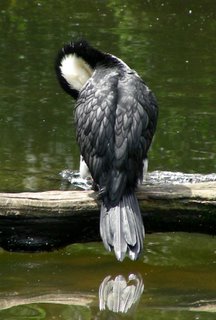 Although pied cormorants (Phalacrocorax varius) are usually solitary, they will put up with one another when the food supply is good. They're also pretty mindful of tiger sharks ...
Although pied cormorants (Phalacrocorax varius) are usually solitary, they will put up with one another when the food supply is good. They're also pretty mindful of tiger sharks ...Cormorants follow the fish in shallow water. They love seagrass beds, which have an abundant supply, but will move into sandy areas if that's where the nosh is best. (They may be camera shy but they're not daft.) But although shallow water is where the food is easiest to find, it is a dangerous place when there are tiger sharks around.
A study in Shark Bay—named in 1699 by William Dampier for its most obvious feature—showed that cormorants move out into deeper water when the temperatures rise. High temperatures mean higher numbers of sharks. The cormorants would rather spend more time in the ocean where there's not much nosh around but it's relatively safe than in the seagrass beds where a meal is guaranteed—for the bird and almost certainly for the shark as well.
_______
*The black-faced cormorant (P. fuscescens) is the exception. It sticks to the coast and there's no convincing it to try something new.
Reference
Heithaus, M.R. (2005). Habitat use and group size of pied cormorants (Phalcrocorax varius) in a seagrass ecosystem: possible effects of food abundance and predation risk. Marine Biology 147: 27 – 35.